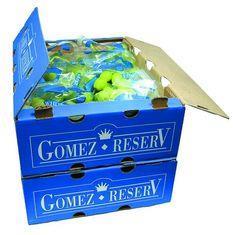
The company sources the bulk of its grapes from Spain and Chile to supply its supermarket customers, but also picks up fruit from Greece, Brazil and South Africa. “Due to our storage capabilities we are able to supply top-quality Spanish and Chilean grape for 10 months of the year,” says Parmenter.
When it comes to new supply sources, he says Gomez is looking at South Africa and Brazil to complement its Spanish and Chilean seasons. “As a company the aim is to offer a 52-week supply in order to give us greater economies of scale and enable us to become more cost-effective for both the supermarket and wholesale sectors.”
Maintaining that steady supply is vital, he says: “In general grapes are a steady business as the different seasons generally overlap. However, we are also affected by uncontrollable variables. For example last year there was a heavy frost in Spain, which damaged the vines, affected yield and subsequently had a detrimental effect on sales.”
In terms of consumer trends, Parmenter says seeded grape sales are continuing to fall as consumer preference grows for seedless varieties. “This is especially true of supermarket customers during the Spanish grape season. Since Gomez introduced Spanish Crimson red seedless to UK consumers, sales have rocketed every year.
“This can be explained by the superb dark crimson colour, firm berry and special sweet taste which cannot be matched by any other readily available grape variety,” he says.
Gomez recognises the fact grape is now a key product in the retail market, bringing an extra level of competition. “It has become a price-match product, in that if one retailer lowers their price, its competitors are forced to follow suit,” says Parmenter. “This means that the rules of supply and demand no longer hold any real significance. With the every-day-low-price practice being carried out by the supermarkets at present, the losers are the suppliers and growers.
“The competition between suppliers is intense but the eventual winners will be the suppliers with the strongest growers who are able to survive the present supermarket price war.”
Parmenter says the biggest fear facing the sector, as a result of the retail price focus, is that the fruit could become devalued if the retailers drop their prices dramatically. “Preventing this from happening is a major challenge,” he states.
Another challenge Gomez faces is that while it strives to provide a 52-week supply, it must find ways to guarantee that the standard of the product does not slip.
“Suppliers must ensure that they do not extend seasons to the detriment of the product and therefore try to smooth-out the overlap between seasons,” says Parmenter.
One the biggest moves the company has made in the grape sector in recent times has been the launch of the Gomez Reserv brand.
The concept is aimed at providing an up-market premium range of produce for the non-multiple sector, says Parmenter, and grapes were one of the first lines to be carried under the brand when it was introduced a year ago.
“Now that a full calendar year has been completed with 12-month supply from Spain, South Africa, Chile and Greece we are able to assess how the grape range has performed in the wholesale market sector,” he says.
“In product life cycle terms, Gomez Reserv grape has just completed the introductory stage after one years worth of sales and in this time, actual sales have been two-and-a-half times our predicted sales.”
He says that at times, demand has been so strong it has been a serious challenge to meet it with supply, although Parmenter adds: “A challenge that was accepted and won. The reason for the strong demand can be explained by one major factor - the grape itself.
“The specification is of such a high standard that there is no other grape that can compete with it on the wholesale market. In fact, the specification demands that Gomez Reserv grape be of a higher quality than grape sold by supermarkets.
“Other grapes on sale in the wholesale sector cannot match the large berries, super sweet taste, firm flesh and fresh green vine and that includes white, red and black grape.”
He says the branded grape is now entering the “growth stage” of the product life cycle. “The key for Gomez is to keep Gomez Reserv grape in the growth stage for as long as possible. Gomez’s strong grower base will make this possible with increased availability to match the increased demand, but at the same time keeping to the strict quality specification demanded by Gomez Reserv.
He added: “Gomez is always searching out new sources for Gomez Reserv but they will only be added to the range if they meet the extremely high quality levels. Gomez Reserv grape is unique.”



